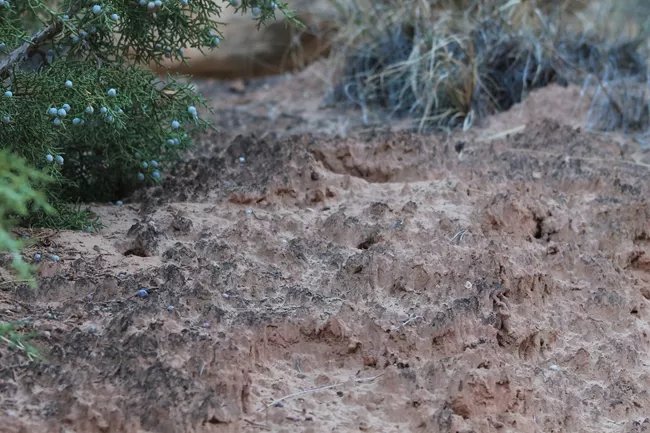If you go to a national park in one of America’s deserts, you may see signs on the hiking trails warning you to stay away from dark patches of sand and scrub, as they are actually alive, and contain one of the most important features of the landscape.
These biological soil crusts are small collections of microorganisms, lichen, and non-vascular desert-dwelling plants, all of which bind together to form a crunchy surface underfoot.
Researchers have recently calculated that the combined presence of these seemingly innocuous organisms may reduce global dust emissions by 55%, preventing the release of approximately 700 million metric tons of dust every year.
“Biological soil crusts help prevent erosion, by holding the soil in place, and trap water moisture in the soil,” reads Utah’s Capitol Reef National Park website. “This black, bumpy crust can be damaged with a single footprint, and can take decades to regrow”.
Controlled experiments have shown that, indeed, desert wind has little effect on sand anchored under these soil crusts, held together with fungal hyphae and increased moisture retention, but the extent to which they affect world climate is unknown. Researchers at the University of Almeria, Spain, have estimated that 25% of all the soil in all the world’s drylands is covered in these biocrusts. This amounts to 12% of all land surface on the globe, a statistic that hints at the global impact of these tiny innocuous colonies of plants and microbes.

Blowin’ in the wind
The movements of dust across the globe are complex, necessary and significant. Dust from the Sahara Desert may have caused the lush jungles of the Amazon Basin to dominate that biome, while they also have the power to create immense meltwater floods if they should happen to fall on snow and ice, where their increased absorption of UV rays leads to increased melting.
To discover how much biocrusts are doing to prevent dust erosion, the scientists first used controlled experimental data to find out at what wind speeds soil particles begin to become dislodged from the biocrust matrix.
After that figure was generated, the team next used an exponential relationship of wind speed averages and geographical location to measure how many tons of dust were lost every year, to find that nearly 700 million tons of soil are prevented every year from being blown to the four corners by these biocrusts.
As it relates to global climate, biocrusts influence the radiative effect airborne dust has on incoming short-wave radiation from the sun, and outgoing long-wave radiation from the surface of the Earth. Subsequently, biocrusts may impact the climatic effects of dust in a comparable manner as the direct effect of all aerosols from human activity, and three times larger than the effect attributed to dust emissions produced by past land-use change.
The impact comes through “radiative forcing,” a process that describes the ratio between how much heat the Earth receives versus how much it radiates out into space. Dust prevents absorbed heat on the Earth’s surface from departing again, trapping it closer to the surface. MIT notes this is often, in regards to climate, theorized to be caused by certain aerosols like black diesel exhaust particles which trap heat.
With this understanding, the scientists’ dust model suggests that these little colonies of organisms prevent an amount of dust equal to all human-created atmospheric aerosols, and three times as many as humans have placed into the atmosphere through land-use changes.
However, if the loss of biocrusts — induced by climate change and land-use intensification — is as severe as expected, by 2070, the authors predict that the global dust burden will increase by up to 15%. WaL
If you think the stories you’ve just read were worth a few dollars, consider donating here to our modest $500-a-year administration costs.



